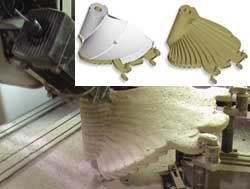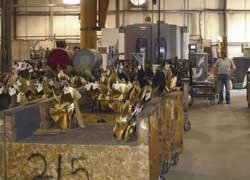Simulation Software Enables "Lights-Out" Five-Axis Machining
Hall & Stavert has been manufacturing marine hardware for more than 65 years. The company incorporated Vericut machine-simulation software to verify NC programs and shorten turnaround time. Developed by CGTech, the solids-based software system interactively simulates the material-removal process of an NC program. The software depicts three- to five-axis milling/drilling and wire EDM operations as well as multi-axis turning and mill/turn machining.
Located in Prince Edward Island, Canada, Hall & Stavert has been manufacturing marine hardware for more than 65 years. The company got its start producing various castings for the local agriculture and fishing industries. Over the years, it shifted its focus to casting and machining marine drive components and marine hardware. More recently, Hall & Stavert has become a large supplier of boat propellers to marine customers such as Sea Ray and General Propeller.
With about 70 employees, the company occupies a 40,000-square-foot facility, which includes a foundry for producing castings from certified metal ingot. On the shop floor, numerous CNC mills and lathes as well as a variety of manual machines often run around the clock.
On one recent job, the company used a five-axis mill to cut a 34-inch diameter propeller pattern totally unattended. In the not-too-distant past, however, any five-axis operation would have required an operator to stand at the machine and watch for potential crashes or gouging, says mechanical engineer Paul Perry. When the company made the plunge into the complex world of five-axis machining, the possibility for errors became much higher than with three-axis programming.
All of this changed about four years ago, when the company incorporated Vericut machine-simulation software to verify NC programs and shorten turnaround time. Developed by CGTech, the solids-based software system interactively simulates the material-removal process of an NC program. The software depicts three- to five-axis milling/drilling and wire EDM operations as well as multi-axis turning and mill/turn machining. Inefficient motion or programming errors that could potentially ruin a part, damage a fixture or break a cutting tool can be corrected before the program runs on an actual machine tool.
The software enables Mr. Perry to see exactly what will happen on the machine, taking much of the anxiety out of the programming process. In addition to avoiding problems on the shop floor, he can test various machining strategies without physically proving them out on the machines. Since implementing the software, the shop says its scrap rate has been “virtually nonexistent,” Mr. Perry says.
“Vericut gives me a very fast turnaround time when processing any job,” Mr. Perry says. “The jobs are set up in Vericut with accurate representation on the machine, controller, tooling and fixturing. If it works in Vericut, it will work on the five-axis mill.”
Another feature assisting the shop with five-axis operations is the software’s ability to model complex milling tools, including cutters with multiple inserts and custom insert shapes. As a result, virtually any revolved milling profile can be used for material-removal simulation, including complex five-axis cuts, the developer says. A material-removal algorithm prevents the animation from slowing down, even on very long multi-axis programs.
Hall & Stavert has discovered other benefits of using the software as well. The program the shop previously used verified CAM operations but not the posted G code. Thus, Mr. Perry had to spend hours checking posted files for any foreseeable mistakes.
“We’ve had a few minor crashes in the past because of mistakes in the occasional posted program,” Mr. Perry says.
Vericut, however, interprets the G code with a control emulator that moves the virtual machine axes. The various actions triggered by the control emulator are then checked for correctness. For example, if the G-code program attempts to cut at an invalid speed or with the spindle spinning in the wrong direction, Vericut issues an error.
Unlike Vericut, the old program did not allow users to dynamically rotate and inspect verified tool paths. After verifying a part with the old software, operators could not zoom in or rotate it for inspection. Viewing the part at a different angle required restarting the application.
In addition to its programming benefits, the software improves efficiency on the shop floor. Before implementing the simulation software, operators would prove out jobs at any given machine with their hands hovering close to the feed and rapid overrides. This method not only took more time to prove out jobs; it often necessitated having to re-post various programs because of problems such as heavy cutting, which can damage inserts.
With the previous method, the shop would need about two shifts (approximately 17 hours) to prove out a new set of programs for a three-axis machine. According to Mr. Perry, the shop can now prove out the same set in less than 8 hours. By enabling faster programming and cutting down on broken tooling, the software has also helped the shop reduce costs.
Related Content
Choosing Your Carbide Grade: A Guide
Without an international standard for designating carbide grades or application ranges, users must rely on relative judgments and background knowledge for success.
Read MoreHow to Turn Machine Shop Downtime Into Process Expertise
To take advantage of a lull in business, JR Machine devised a week-long cutting tool event that elevated the shop’s capabilities with aerospace alloys.
Read MoreHow to Mitigate Chatter to Boost Machining Rates
There are usually better solutions to chatter than just reducing the feed rate. Through vibration analysis, the chatter problem can be solved, enabling much higher metal removal rates, better quality and longer tool life.
Read MoreToolpath Improves Chip Management for Swiss-Type Lathes
This simple change to a Swiss-type turning machine’s toolpath can dramatically improve its ability to manage chips.
Read MoreRead Next
The Cut Scene: The Finer Details of Large-Format Machining
Small details and features can have an outsized impact on large parts, such as Barbco’s collapsible utility drill head.
Read More3 Mistakes That Cause CNC Programs to Fail
Despite enhancements to manufacturing technology, there are still issues today that can cause programs to fail. These failures can cause lost time, scrapped parts, damaged machines and even injured operators.
Read More











.png;maxWidth=300;quality=90)
















